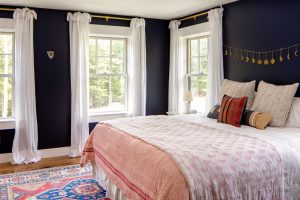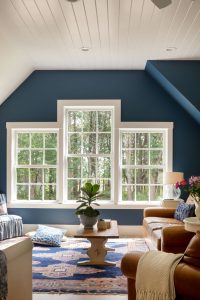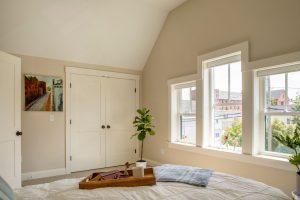Various interior design styles have emerged over time, each embodying distinct characteristics that contribute to the way we experience our spaces. From the bold and eclectic choices of maximalism to the clean lines of Scandinavian design, each style brings a unique perspective on function and beauty.
Here are four popular interior design styles we think you should know:
Maximalism
Maximalism embraces the bold use of color, pattern, and ornamentation and is often characterized by a “more is more” approach. Maximalism encourages layering various textures, styles, and decor elements to create visually stimulating and personalized spaces. Key features of Maximalism design include:
- Bold Colors: Bright and saturated hues are often used in various combinations which result in a vibrant atmosphere.
- Eclectic Patterns: Mixing different patterns from florals, animal prints, to geometric designs to create intentional contrasts and an eclectic look.
- Art and Accessories: Extensive use of artwork, decorative pieces, and collectibles often displayed as a gallery wall.
- Textures: Combining materials such as velvet, leather, wood, and metal to create depth and visual interest.
- Personal Touches: Each space is uniquely curated to reflect the occupant’s personality, interests, and travel experiences to set the room apart from the rest.
Mid-Century Modern
Mid-Century Modern design emerged in the mid-20th century and is recognized for its clean lines, functional forms, and its integration with nature. This style emphasizes simplicity while celebrating both aesthetics and practicality. Key features of Mid-Century Modern design include:
- Open Floor Plans: Spaces that seamlessly flow into one another, open floor plans became popular during this movement.
- Organic Shapes: Furniture often features soft, organic shapes that promote comfort and ease of use.
- Natural Materials: Heavy use of wood, especially walnut, teak, and rosewood, alongside other natural materials like leather and glass.
- Furniture: Minimal clutter with the “less is more” approach and sleek furniture designs, often with tapered legs that create an airy feel.
- Color Palettes: Colors found in Mid-Century Modern design often include muted earth tones and pops of vibrant colors like mustard yellow, teal, or burnt orange.
Bohemian
The Bohemian style, often referred to as “Boho,” is a colorful and eclectic interior design style that embodies a free-spirited and relaxed attitude. Boho style draws inspiration from various cultures and artistic movements, often creating a cozy and lived-in environment. Key features of Bohemian design include:
- Layered Textiles: Use of various fabrics like tapestry, throws, and rugs layered to add warmth and texture.
- Eclectic Decor: Incorporation of global influences such as Moroccan poufs, Indian prints, or rustic artifacts.
- Greenery: A strong presence of plants and natural elements, promoting a refreshing vibe and connection to nature.
- Lighting: Soft ambient lighting such as string lights, candle stands, table lamps and lanterns create a cozy atmosphere in this design style.
- Mixing Eras and Styles: Furniture and decor from different times and places can coexist beautifully, reflecting the owner’s tastes and travels.
Scandinavian
Scandinavian design is known for its minimalistic aesthetic, functionality, and connection to nature. This style emphasizes simplicity, lightness, and practicality while providing a warm and inviting ambiance. Key features of Scandinavian design include:
- Neutral Color Palette: Predominantly features whites, neutrals, grays, and soft pastels that create a serene and airy atmosphere.
- Natural Light: Maximizing natural light with open spaces, large windows, and light-colored furnishings to enhance brightness.
- Functional Furniture: A focus on practical and beautiful furniture that is often crafted from wood that emphasizes comfort and usability.
- Textured Layers: Incorporating textiles such as linen, wool, and cotton for coziness, often through throw pillows, blankets, and cushions.
- Nature-Inspired Elements: A connection to nature that promotes a sense of peace is reflected through materials, shapes, and greenery.
For more information on Scandinavian design, check out the recent Rent. article we were featured in:
Among the various decorating trends; like maximalism, mid-century modern, and bohemian, one stands out and even influences others. Scandinavian decor, as seen at your local IKEA, is characterized by a combination of simplicity, functionality, and a strong emphasis on natural elements. With its growing popularity and increasing influence on minimalism, Scandinavian decor is a worthwhile deep dive for those design enthusiasts in search of a crisp and clean functional space. When navigating the design world, whether you’re buying a home in Raleigh, NC, considering a rental home in Denver, CO, or renting an apartment in Fort Worth, everything you ever wanted to know can be found within this Rent. Scandinavian decor guide, without an airline ticket or an interior designer.
Read the full article here: Scandinavian Decor: What is it and What are Its Defining Features? | Rent.



